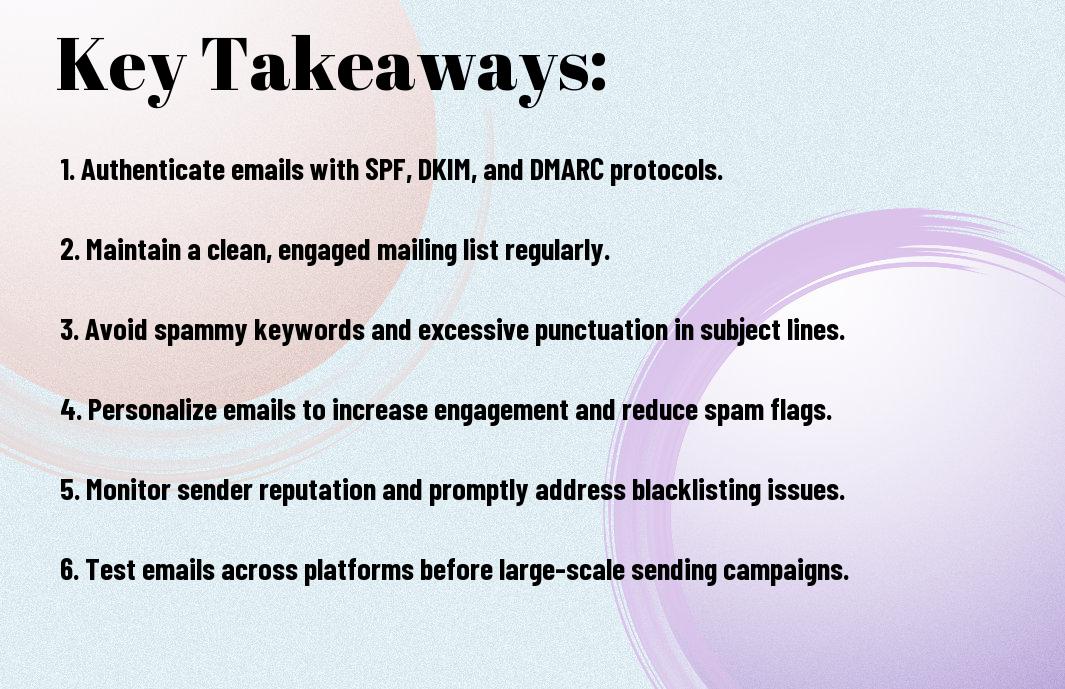Most email marketers experience the frustration of having their messages end up in spam folders, beyond the reach of your audience. Understanding the factors that influence email deliverability is necessary for ensuring your communications effectively reach the intended recipients. In this post, you will discover practical tips to improve your email sending practices, enhance your sender reputation, and ultimately keep your messages out of the spam abyss, allowing your valuable content to shine through in your recipients’ inboxes.

Key Takeaways:
- Regularly authenticate your email domain with DKIM, SPF, and DMARC to improve sender reputation.
- Optimize email content by avoiding spammy words and keeping a balanced text-to-image ratio.
- Maintain a clean email list by regularly removing inactive subscribers and managing bounces effectively.
- Engage your audience with personalized content to increase open and click-through rates, which boost deliverability.
- Monitor email metrics and adjust your strategy based on bounce rates, open rates, and user engagement data.

The Anatomy of Email Spam Filters
Email spam filters are intricate systems designed to safeguard inboxes from unsolicited content. They analyze various characteristics of incoming emails, utilizing algorithms to evaluate their legitimacy based on a set of criteria. Each filter examines elements such as sender reputation, content quality, and user engagement metrics to determine whether an email is worthy of reaching its destination or if it should be redirected to the spam folder.
How Spam Filters Operate
<p.Spam filters employ a combination of techniques including blacklists, whitelists, and machine learning algorithms. When you send an email, filters scan for specific spammy keywords and assess your sending reputation based on prior user interactions. If your email meets too many spam-like criteria, it could be flagged, reducing the likelihood of successful delivery.
Key Metrics Influencing Deliverability
<p.Vital metrics shaping your email deliverability include sender reputation, open rates, bounce rates, and engagement levels. Consistently high open and click-through rates signal to filters that your messages are valuable, positively impacting your reputation, while low engagement or high bounce rates can quickly lead to your emails being sidelined.
<p.Sender reputation is pivotal—it's built over time from your email engagement history. ISPs monitor how recipients interact with your emails. High bounce rates—a result of invalid emails—can damage your credibility, while positive metrics, such as open rates above 20%, help reinforce your standing. Engagement rates, particularly those reflected in click-through statistics, serve as indicators of content relevance. The more a recipient interacts with your emails, the greater your reputation and the likelihood of landing in the primary inbox rather than the spam folder.

Building a Solid Sender Reputation
A solid sender reputation is vital for ensuring your emails reach the intended inbox. Factors such as open rates, click-through rates, and subscriber engagement all contribute to your reputation score. You’ll want to cultivate a positive reputation by maintaining a clean email list, engaging with your audience, and avoiding practices that can lead to spam reports. Consistency in your sending behavior can also bolster your reputation and build trust with Internet Service Providers (ISPs).
The Role of Authentication Protocols
Your emails require proper authentication to confirm their legitimacy. Implementing protocols like SPF, DKIM, and DMARC can significantly enhance your sender reputation. These protocols verify that the email sender is authorized, thereby preventing spoofing and phishing attempts. When ISPs see your emails are authenticated, they’re more likely to deliver them straight to the inbox.
Monitoring Bounce Rates and Engagement
Watching your bounce rates and overall engagement is crucial to maintaining a good sender reputation. High bounce rates can signal that your email list contains outdated or invalid addresses, leading to a negative reputation with ISPs. Regularly updating your list and segmenting your audience can help you engage those who are genuinely interested in your content.
Low engagement rates, alongside high bounce rates, can hinder your email deliverability. You might find that a significant number of recipients aren’t opening your emails or are opting out of your list. Analyzing this data gives you insight into what content resonates and what strategies to adjust. For instance, if you’re noticing a pattern of low engagement with promotional emails, consider offering more value-driven content. By refining your approach based on engagement metrics and bounce feedback, you can enhance your email campaigns and improve sender reputation, paving the way for more successful deliveries in the future.
Crafting Emails That Bypass Filters
Your email design and copy play pivotal roles in determining whether your messages confidently land in the inbox or face the dreaded spam folder. Start with engaging, personalized content that speaks directly to your audience. This tailored approach, combined with an understanding of what raises red flags in filters, can bolster your deliverability rates. The right combination of language, formatting, and usability ensures that your outreach stands out without alarming the algorithms that guard inboxes.
Language and Formatting to Avoid Triggers
Selecting your words carefully can make all the difference in email deliverability. Avoid excessive use of buzzwords, promotional jargon like “free,” “guaranteed,” or “urgent.” Implement a consistent tone and include HTML coding that aligns with best practices, steering clear of excessive capitalization or exclamation marks which can trigger spam filters.
Balancing Aesthetics and Usability
Your email should look appealing and be easy to navigate. Striking the right balance between eye-catching design elements and practicality can enhance user experience. Excessive imagery or overly complex layouts may confuse both recipients and filters alike.
Simple, clean layouts help keep focus on your content while maintaining visual interest. Use a mix of images and text while ensuring images have descriptive alt tags. Always prioritize mobile optimization since over 50% of emails are opened on mobile devices. Do not forget, a well-structured email ensures recipients can easily engage with your message, boosting both click rates and deliverability scores.
Engaging Your Audience to Enhance Deliverability
Engaging your audience is key to improving email deliverability. When your recipients interact with your content—by opening, clicking, or replying—email providers recognize your messages as valuable and relevant. Building strong connections ensures recipients look forward to your emails rather than viewing them as spam. Regularly gauging audience interests and adapting your content accordingly fosters a positive relationship, which not only maintains your sender reputation but dramatically increases the likelihood of landing in the inbox.
List Segmentation and Targeting
Effective list segmentation allows you to tailor content to the specific interests and behaviors of your audience segments. Instead of sending a generic message to your entire list, categorize subscribers based on attributes such as location, purchase history, engagement level, or preferences. This targeted approach ensures that subscribers receive information that resonates with them, leading to higher engagement rates and minimizing the risk of your emails being marked as spam.
Best Practices for Re-engagement Campaigns
Re-engagement campaigns serve to reconnect with subscribers who have become inactive. Successful strategies include personalized content, attention-grabbing subject lines, and exclusive offers to reignite interest. Using automation tools, you can identify disengaged users based on their activity and craft tailored messages to encourage them to interact with your emails once again.
When executing a re-engagement campaign, start by segmenting subscribers who haven’t opened your emails in the last three to six months. Deliver a series of emails designed to capture their attention—consider asking recipients for feedback on their preferences or offering special incentives such as discounts or early access to new products. Monitor engagement metrics to assess the success of your efforts and judiciously prune your list of persistent non-engagers to maintain a high sender reputation, ultimately improving overall deliverability.
Navigating ISP Relationships for Better Outcomes
Building strong relationships with Internet Service Providers (ISPs) significantly impacts your email deliverability. Understanding their guidelines and fostering rapport with email service providers ensures your messages reach inboxes instead of spam folders. Proper adherence will allow you to create a proactive email strategy that works seamlessly within the ISP frameworks, ultimately improving your overall email performance.
Understanding Internet Service Providers’ Guidelines
ISPs have specific guidelines that dictate how they handle incoming emails. Familiarizing yourself with these criteria is vital for ensuring that your emails comply with their standards. Common guidelines include the use of proper authentication protocols like SPF, DKIM, and DMARC, maintaining a clean mailing list, and conforming to regulations like the CAN-SPAM Act. Understanding these frameworks can help you avoid pitfalls that lead to spam filtering.
Building Rapport with Email Service Providers
Establishing a positive relationship with your email service provider is vital for improving deliverability rates. Regular communication, transparent feedback, and collaborative problem-solving are effective strategies for fostering this connection. By engaging with your provider, you increase the chances of receiving helpful insights and support tailored to your specific needs, and their willingness to assist you in optimizing your email campaigns usually improves.
For example, setting up a dedicated contact within your email service provider can lead to quicker responses during troubleshooting. Additionally, sharing your campaign goals and metrics regularly can position you as a valued partner, encouraging the provider to prioritize your deliverability concerns. Networking with your provider’s support team helps you stay informed about any updates or changes in policies that may affect your email strategy. This proactive approach lays the groundwork for a robust and mutually beneficial relationship, enhancing your overall emailing successes.
Final Words
The key to improving your email deliverability lies in understanding how to prevent your messages from landing in spam folders. By following best practices, such as maintaining a clean email list and optimizing your content, you can enhance your chances of reaching your audience effectively. For a comprehensive guide, explore Email Deliverability: How to Dodge the Spam Folder, which offers valuable insights to ensure your emails are delivered as intended.
FAQ
Q: What factors can cause my emails to land in spam folders?
A: Several elements can contribute to emails being filtered as spam. These include using spammy keywords in your subject lines or content, having a poor sender reputation due to previous complaints, lack of authentication records like SPF, DKIM, and DMARC, and sending emails to unengaged or invalid addresses. Consistently monitoring and improving your email practices can help mitigate these issues.
Q: How can I improve my email sending reputation?
A: Enhancing your email sending reputation involves several steps. First, maintain a clean email list by regularly removing inactive subscribers and invalid addresses. Second, engage your audience with high-quality content that encourages interaction. Third, avoid purchasing email lists, which can lead to complaints and spam reports. Lastly, monitor your sender score and follow best practices to ensure a positive reputation over time.
Q: What are SPF, DKIM, and DMARC, and how do they help with email deliverability?
A: SPF (Sender Policy Framework), DKIM (DomainKeys Identified Mail), and DMARC (Domain-based Message Authentication, Reporting, and Conformance) are email authentication protocols that help improve email deliverability. SPF verifies that the email sender is authorized to send on behalf of the domain. DKIM adds a digital signature to emails, confirming that the email content hasn’t been altered during transmission. DMARC combines both SPF and DKIM, enabling domain owners to set rules for handling suspicious emails. Implementing these protocols can significantly enhance your chances of avoiding spam filters.
Q: Why is it important to monitor email engagement and how can it affect deliverability?
A: Monitoring email engagement is necessary because it directly impacts your sender reputation. Low engagement rates, such as low open or click-through rates, may signal to email service providers that your communications are not relevant or wanted by recipients. This can lead to increased chances of landing in spam folders. To improve engagement, segment your audience, personalize content, and ensure that you are providing value so that recipients are more likely to interact with your emails.
Q: What steps can I take to encourage recipients to whitelist my email address?
A: Encouraging recipients to whitelist your email address can improve your deliverability. You can achieve this by asking them to add you to their contact list or marking your emails as important. Additionally, you can provide clear instructions on how they can do this based on their email client. Engaging your audience with high-quality content and maintaining consistent communication can also increase the likelihood of them whitelisting your address, thus ensuring they receive your emails in their inbox.

